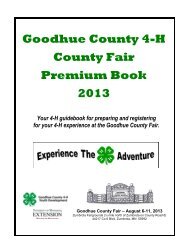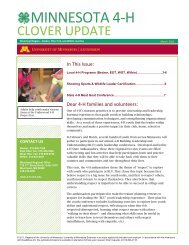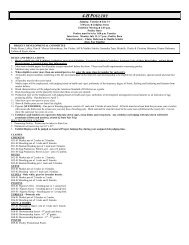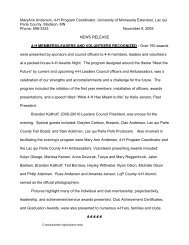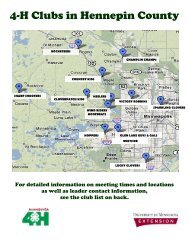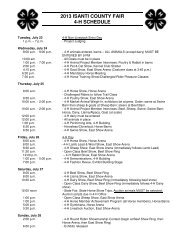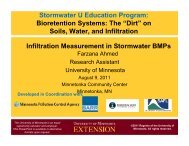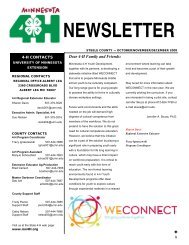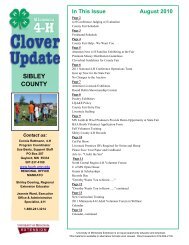2008 Central MN Alfalfa Scissors Cut Project - University of ...
2008 Central MN Alfalfa Scissors Cut Project - University of ...
2008 Central MN Alfalfa Scissors Cut Project - University of ...
You also want an ePaper? Increase the reach of your titles
YUMPU automatically turns print PDFs into web optimized ePapers that Google loves.
Comments:<br />
Please make SAFETY a priority along with aiming to put up palatable hay or haylage feed.<br />
May 22 - Stands in these fields look good. They have been slow-growing because <strong>of</strong> cool weather.<br />
Cool weather tends to lower fiber and raise digestibility with less stem elongation and higher leaf/stem ratio.<br />
Cool weather is thought to lower protein level. Protein on these samples were in a 26-27 range.<br />
Cloudy weather tends to raise fiber and lower digestibility.<br />
Wet weather tends to increase fiber with more stem elongation and a lower leaf to stem ratio.<br />
It could be that it's been cold enough to stress plants and lower digestibility. It could be as plants put on new<br />
growth, RFV that appear to run lower now compared to height will be more in line. Time will tell. In the cool<br />
spring <strong>of</strong> 1997 most <strong>of</strong> our cooperators got into harvest around June 2-4.<br />
2002 was also a cool and also a wet spring. It stayed wet through the summer. In 2002 sample fields at<br />
Buffalo Eden Valley, Freeport measured 10 to 13 inches. <strong>Alfalfa</strong> on these farms was cut after June 6.<br />
Let's watch what a warmer weekend does. With Memorial Day on Monday, the next samples will likely be<br />
taken on Tuesday May 27 and then Thursday May 29. I'm told things are farther along as we go south in<br />
Minnesota.<br />
You can look at Wisonsin <strong>Scissors</strong> <strong>Cut</strong> data at:<br />
http://www.uwex.edu/ces/ag/scissorsclip<br />
May 28 - We have seen significant growth during the last week. It's not uncommon when conditions are not<br />
normal to see some numbers that don't look normal. It's not unusual to see some variation between PEAQ<br />
numbers and NIR lab tests. REMEMBER the margin <strong>of</strong> error on the NIR analysis is + or - 10 points. So if there<br />
was a way to know the lab test RFV should actually be 180, the range for a test could reasonabley 170 to 190. A<br />
RFV number from wet lab chemistry probably isn't much different. That does NOT make it useless, it just<br />
means you have to keep your brain plugged in and be a good student <strong>of</strong> your experience from year to year with<br />
the crop and with cows to apply what you could be learned from tests and field measurements. There is a<br />
margin <strong>of</strong> error for the PEAQ process. UWEX Dan Undersander, in the past has spoken with greater<br />
confidence in PEAQ numbers. Cool weather tends to improve digestibility, but can it be cold enough to stress<br />
the plant and get lower quality numbers than indicated by height and maturity?<br />
We consider many guides for making harvest decisions any one <strong>of</strong> them (or a combination) could be the<br />
trump card in a given situation - Calendar, PEAQ reading, Lab NIR test, ADF, NDF, 22-26 inch height, buds<br />
showing, out <strong>of</strong> hay, kids leave for camp next week.<br />
I'm NOT trying to do anyone's thinking for them (that's the farm operator's task - perhaps with your nutrition<br />
advisor) but here are some scenarios to illustrate some things people might be thinking:<br />
1) It's the end <strong>of</strong> May, I want to maintain a cutting schedule for the rest <strong>of</strong> the summer, if the weather is<br />
good and the crop test is somewhere near the range I want, I could be cutting.<br />
2) Like number 1 and I'm on lighter soils that don't usually support a hay crop in the middle <strong>of</strong> the summer,<br />
I'm going to harvest and make use <strong>of</strong> current moisture to get the 2nd crop started.<br />
3) As at Stocker's on May 27, The PEAQ is 190 the lab says 162, its the end <strong>of</strong> May, I'm seeing buds. If I<br />
think the real answer 190, I might land 170 in the feed bunk. If I think the real answer is 162, I might land at 140<br />
in the feed bunk. If being in a 140 to 170 range works well for my cows, and the weather looks suitable for<br />
harvest, I'm probably cutting for milk cow quality hay.<br />
4) At Krause's on May 27, at 20.4 inches, vegetative stage, PEAQ and NIR running close at 210 and 201,<br />
ADF is creeping toward 30, but NDF is not as far along - if I don't feel pressed by the calendar or the weather on<br />
this farm, I think I'm OK to wait for the next one.<br />
5) At Frerick's farm, a PEAQ at 217 and NIR at 264 and ADF NDF at 23/25 - it doesn't matter what the<br />
neighbors are doing or what's on the calendar. That fits a pattern with the first test. I'm looking at abundant<br />
leaves and fine stems yet. Looking at the Calendar I'd like to be cutting. In the past a crop cut like this is too hot<br />
to handle. Its better for me to wait, gain some growth, look at the next test.<br />
6) Ackerman or O&S Dairy are maybe a little tougher. PEAQ 217, NIR 197, ADF/NDF at 24/33 I could have<br />
time to wait, or the calendar, weather, importance <strong>of</strong> getting second cutting started could tip the balance toward<br />
doing some cutting. Past experience is important. If I land in the feed bunk at 190 to 200, am I ready with my<br />
nutrition advisor to deal with it effectively in the ration in the context <strong>of</strong> other feed ingredients we are working<br />
with?<br />
Harvest strategies can make a difference in how things turn out. I think nutrition people have told me if I am<br />
harvesting at higher RFV and also put it up on the wet side, like haylage at 65-70% moisture, I increase the<br />
challenge <strong>of</strong> dealing with high soluable protein levels. See Jim Linn's discussion in Dairy Star 5/24.



